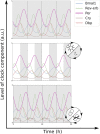Synergies of Multiple Zeitgebers Tune Entrainment
- PMID: 36925578
- PMCID: PMC10013031
- DOI: 10.3389/fnetp.2021.803011
Synergies of Multiple Zeitgebers Tune Entrainment
Abstract
Circadian rhythms are biological rhythms with a period close to 24 h. They become entrained to the Earth's solar day via different periodic cues, so-called zeitgebers. The entrainment of circadian rhythms to a single zeitgeber was investigated in many mathematical clock models of different levels of complexity, ranging from the Poincaré oscillator and the Goodwin model to biologically more detailed models of multiple transcriptional translational feedback loops. However, circadian rhythms are exposed to multiple coexisting zeitgebers in nature. Therefore, we study synergistic effects of two coexisting zeitgebers on different components of the circadian clock. We investigate the induction of period genes by light together with modulations of nuclear receptor activities by drugs and metabolism. Our results show that the entrainment of a circadian rhythm to two coexisting zeitgebers depends strongly on the phase difference between the two zeitgebers. Synergistic interactions of zeitgebers can strengthen diurnal rhythms to reduce detrimental effects of shift-work and jet lag. Medical treatment strategies which aim for stable circadian rhythms should consider interactions of multiple zeitgebers.
Keywords: circadian clock; mathematical model; resonance; synchronisation; zeitgeber synergy.
Copyright © 2022 Grabe, Mahammadov, Olmo and Herzel.
Conflict of interest statement
The authors declare that the research was conducted in the absence of any commercial or financial relationships that could be construed as a potential conflict of interest. The handling editor declared a past collaboration with one of the authors HH.
Figures








References
LinkOut - more resources
Full Text Sources

